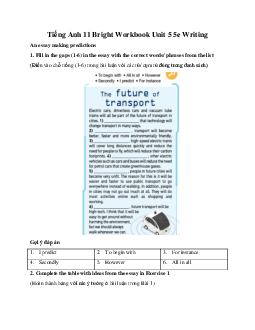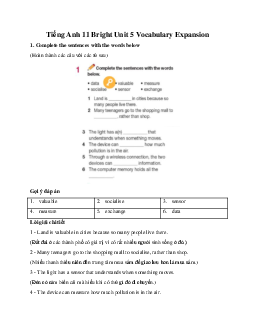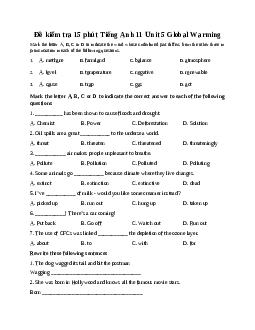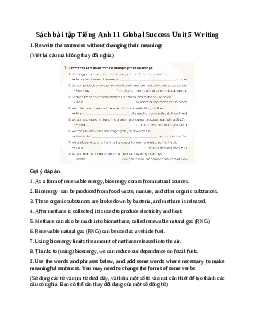




Preview text:
Tiếng Anh 11 Global Success Unit 5 Reading
The UN Climate Change Conference
1. Work in pairs. Look at the pictures and discuss the environmental problems you see.
(Làm việc theo cặp. Nhìn vào các bức tranh và thảo luận về các vấn đề môi trường mà bạn nhìn thấy) Gợi ý đáp án
Picture A: Deforestation is a significant environmental issue that occurs when forests are
cut down for various reasons. This can result in a loss of plant and animal species, soil
erosion, and climate change. Deforestation can negatively impact human communities
that rely on forests for their livelihoods. It is important to take action to prevent
deforestation and protect our forests for future generations.
Picture B: CO2 emissions are a significant environmental problem that occurs when large
amounts of carbon dioxide are released into the atmosphere from human activities. This
contributes to the greenhouse effect and global warming, which can have serious
consequences such as rising sea levels and more extreme weather events.
2. Read the article and choose the best title for it.
(Đọc bài báo và chọn tiêu đề tốt nhất cho nó) Gợi ý đáp án
C. Main goals of this year’s COP Nội dung bài đọc
Năm 1994, Liên Hợp Quốc quyết định tập hợp các nhà lãnh đạo thế giới cho một sự kiện
thường niên, được gọi là COP hoặc 'Hội nghị các Bên', để thảo luận về biến đổi khí hậu.
Hội nghị năm nay sẽ xem xét những gì đã đạt được và thảo luận về các mục tiêu chính.
Mục tiêu đầu tiên là hạn chế mức tăng nhiệt độ toàn cầu ở mức 1,5°C. Điều này sẽ yêu
cầu giảm 50% lượng khí thải CO2 toàn cầu vào năm 2030 và đến năm 2050 đạt được sự
cân bằng giữa khí nhà kính thải vào khí quyển và những khí thải ra khỏi khí quyển.
Mục tiêu thứ hai là giảm sử dụng than đá, loại nhiên liệu bẩn nhất và là nguồn phát thải
CO2 làm nóng hành tinh lớn nhất. Các quốc gia sẽ phải ngừng xây dựng các nhà máy
than mới và chuyển sang các nguồn năng lượng sạch.
Mục tiêu thứ ba là chấm dứt nạn phá rừng. Rừng loại bỏ CO2 khỏi khí quyển và làm
chậm sự nóng lên toàn cầu. Nhưng khi chúng bị đốn hạ hoặc đốt cháy, chúng thải carbon
dự trữ trong cây vào khí quyển dưới dạng CO2. Do đó, ngăn chặn nạn phá rừng là một
giải pháp hiệu quả cho biến đổi khí hậu.
Mục tiêu quan trọng cuối cùng là giảm phát thải khí mê-tan. Khí mê-tan là một loại khí
nhà kính mạnh hơn CO2, trong việc làm trái đất nóng lên. Nó chịu trách nhiệm cho gần
một phần ba sự nóng lên hiện nay từ các hoạt động của con người. Khí mê-tan đến từ các
hoạt động nông nghiệp và chất thải chôn lấp. Việc sản xuất và sử dụng than đá, dầu mỏ
và khí đốt tự nhiên cũng giải phóng khí mê-tan.
Hội nghị này rất quan trọng vì đây là cơ hội cuối cùng tốt nhất mà chúng ta có để làm
chậm sự nóng lên toàn cầu. Các nhà lãnh đạo thế giới, chuyên gia khí hậu, tổ chức và đại
diện quốc gia sẽ thảo luận kỹ lưỡng về các mục tiêu này và đồng ý về cách đạt được tiến
bộ toàn cầu về biến đổi khí hậu.
3. Read the article again. Match the highlighted words with their meanings.
(Đọc lại bài viết. Nối các từ được đánh dấu với ý nghĩa của chúng) Gợi ý đáp án 1. d 2. c 3. b 4. a
4. Read the article again and choose the correct answers A, B, or C.
(Đọc bài viết một lần nữa và chọn câu trả lời đúng A, B hoặc C) Gợi ý đáp án 1. C 2. A 3. C 4. B 5. B
5. Work in groups. Discuss the following question. (Thảo luận câu hỏi sau)
What should we do to reduce global warming? Gợi ý đáp án
There are several actions that individuals and governments can take to reduce global warming:
1. Reduce energy consumption: One of the main sources of greenhouse gas emissions is
the burning of fossil fuels to produce energy. We can reduce energy consumption by
turning off lights and appliances when not in use, using energy-efficient light bulbs
and appliances, and reducing the use of air conditioning and heating.
2. Use renewable energy sources: Renewable energy sources such as solar, wind, and
hydropower emit little to no greenhouse gases. Governments can invest in renewable
energy infrastructure, and individuals can install solar panels on their homes or
participate in community solar programs.
3. Reduce, reuse, and recycle: The production of goods and the disposal of waste are
also sources of greenhouse gas emissions. By reducing the amount of waste we
generate, reusing products as much as possible, and recycling materials, we can
reduce emissions and conserve resources.
4. Plant trees and conserve forests: Trees absorb carbon dioxide from the atmosphere,
so planting trees and conserving forests can help reduce greenhouse gas emissions.
5. Support climate-friendly policies and actions: Governments can implement policies
and actions that promote clean energy, reduce emissions, and protect the
environment. As individuals, we can also support these policies and take action to reduce our own emissions.




